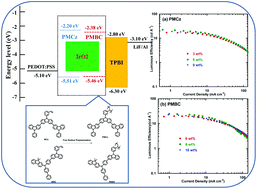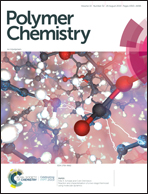Wide bandgap poly(meta-styrene) derivatives containing pendant carbazolyl groups as hosts for efficient solution-processed organic light emitting diodes†
Abstract
Two novel poly(meta-styrene) derivatives (PMCz and PMBC) containing 9,9′′-diphenyl-9H,9′H,9′′H-3,3′:6′,3′′-tercarbazole (TCz) and N-([1,1′-biphenyl]-4-yl)-9,9-dimethyl-N-(4-(9-phenyl-9H-carbazol-3-yl)-phenyl)-9H-fluoren-2-amine (BCFN) were designed and synthesized via free-radical polymerization. The target polymers exhibited good thermal stability with a high glass transition temperature of 139 °C and 114 °C for PMCz and PMBC, respectively. The resulting PMCz and PMBC exhibited relatively high triplet energy levels of 2.86 eV and 2.70 eV, respectively, indicating their great potential for application as host materials for the orange phosphorescence iridium complex. It is also noted that the photoluminescence spectra of both the resulting copolymers obviously overlapped with the absorption profile of the phosphorescent emitter IrO2, indicating efficient Förster energy transfer when blending IrO2 into PMCz or PMBC. The orange phosphorescent organic light-emitting diode based on PMBC as the host and IrO2 as the dopant exhibited a maximum luminous efficiency of 25.0 cd A−1 and low efficiency roll-off, indicating the great potential for the application of the resulting wide bandgap copolymers as hosts for solution processed phosphorescent OLEDs.



 Please wait while we load your content...
Please wait while we load your content...